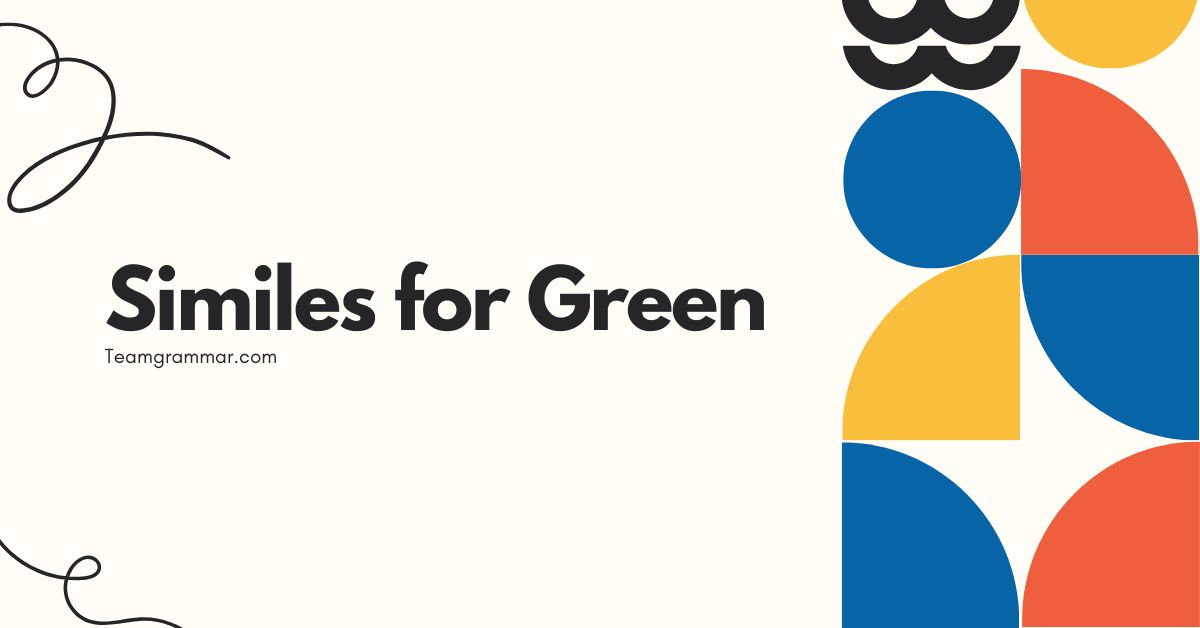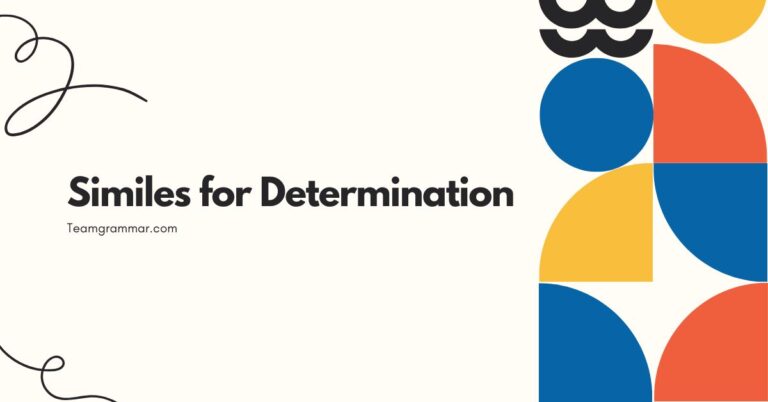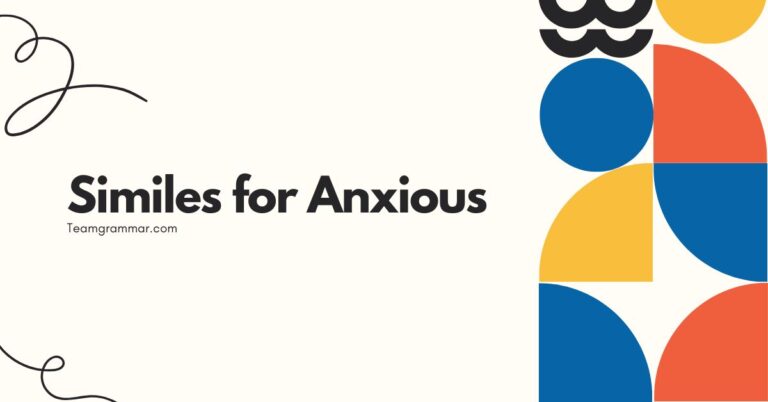48 Similes for Green: Enhancing Your Descriptive Language
Similes are powerful tools in the English language, allowing writers and speakers to create vivid imagery and make their descriptions more engaging. Understanding how to use similes effectively, especially when describing colors like green, can significantly enhance your communication skills.
This article provides a comprehensive guide to similes for green, exploring their structure, usage, and various examples. Whether you’re a student, writer, or language enthusiast, this guide will equip you with the knowledge and practice to master the art of using similes to describe the color green.
Table of Contents
- Introduction
- Definition of a Simile
- Structural Breakdown of Similes
- Types of Similes
- Examples of Similes for Green
- Usage Rules for Similes
- Common Mistakes with Similes
- Practice Exercises
- Advanced Topics in Similes
- Frequently Asked Questions
- Conclusion
Definition of a Simile
A simile is a figure of speech that compares two unlike things using the words “like” or “as.” The primary function of a simile is to create a vivid and imaginative comparison that helps the audience understand or visualize something more clearly. Similes are classified as figurative language, meaning they deviate from the literal meaning of words to create a specific effect.
Similes are used in various contexts, including literature, poetry, everyday conversation, and advertising. They add depth and color to descriptions, making them more memorable and engaging.
For example, instead of saying “the grass is green,” a simile might say “the grass is as green as an emerald,” creating a richer and more evocative image.
Structural Breakdown of Similes
The basic structure of a simile consists of three main components: the subject, the linking word (“like” or “as”), and the object of comparison. The subject is the thing being described, and the object of comparison is the thing it is being compared to.
The linking word establishes the comparison between the two.
A typical simile follows this pattern:
Subject + Linking Word (like/as) + Object of Comparison
For example:
The leaves (subject) are as (linking word) green as jade (object of comparison).
Understanding this structure is crucial for creating effective and clear similes. It ensures that the comparison is logical and easy to understand.
Types of Similes
While all similes share the same basic structure, they can be categorized based on the type of comparison they make. Here are a few common types:
Descriptive Similes
These similes focus on describing a particular quality or characteristic of the subject. They are often used to enhance the sensory experience of the reader.
Example: The pond was as green as a well-worn army tent.
Exaggerative Similes
These similes use hyperbole to emphasize a particular aspect of the subject. They are often used for comedic effect or to create a strong impression.
Example: The mold was as green as an alien from another planet.
Understated Similes
These similes use understatement to create a subtle comparison. They can be more impactful than more direct comparisons.
Example: The green smoothie was barely as green as a lime.
Examples of Similes for Green
Here are numerous examples of similes for the color green, categorized for clarity and inspiration. Each category showcases different aspects and intensities of the color green.
Nature-Based Similes
These similes draw comparisons from the natural world, such as plants, trees, and landscapes. They often evoke feelings of freshness, growth, and tranquility.
The table below provides examples of nature-based similes for the color green. These similes aim to connect the color green with familiar elements of the natural world, enhancing the reader’s ability to visualize and relate to the descriptions.
| Simile | Explanation |
|---|---|
| As green as a lush meadow | Describes a vibrant, healthy green similar to a field of thick grass. |
| Like the green of emerald leaves | Compares the color to the deep, rich green of emerald gemstones. |
| Green as a forest canopy | Refers to the dense, overarching green of trees in a forest. |
| As green as spring grass | Evokes the fresh, bright green of newly grown grass in the springtime. |
| Like a verdant valley | Compares the color to a lush, green valley full of life. |
| Green as a mossy rock | Describes a muted, earthy green similar to moss-covered rocks. |
| As green as a lime | Refers to the bright, slightly yellowish-green of a lime fruit. |
| Like the green of a jade stone | Compares the color to the smooth, deep green of jade. |
| Green as a field of spinach | Describes a dark, leafy green reminiscent of spinach. |
| As green as a Granny Smith apple | Evokes the bright, slightly tart green of a Granny Smith apple. |
| Like the green of sea algae | Compares the color to the various shades of green found in sea algae. |
| Green as a pine tree | Describes the deep, evergreen color of pine needles. |
| As green as a cucumber | Refers to the pale, fresh green of a cucumber. |
| Like the green of a fern | Compares the color to the delicate, intricate green of fern leaves. |
| Green as a sprig of mint | Describes a vibrant, aromatic green similar to fresh mint. |
| As green as a pea pod | Evokes the smooth, bright green of a pea pod. |
| Like the green of a cactus | Compares the color to the muted, resilient green of a cactus. |
| Green as a patch of clover | Describes a dense, vibrant green similar to a patch of clover. |
| As green as a kiwi | Refers to the bright, tangy green of a kiwi fruit’s flesh. |
| Like the green of a bell pepper | Compares the color to the glossy, bright green of a bell pepper. |
| As green as a blade of grass | Describes a light, fresh green, like that of a single blade of grass. |
| Like the green of a rolling hill | Compares the color to the expansive, undulating green of grassy hills. |
| Green as an avocado | Describes a rich, creamy green similar to the flesh of an avocado. |
| As green as a sprout | Refers to the tender, vibrant green of newly emerged sprouts. |
Object-Based Similes
These similes compare the color green to man-made objects, often associated with specific feelings or contexts. These similes can be more abstract and creative.
The table below provides examples of object-based similes for the color green. These similes aim to connect the color green with familiar objects, enhancing the reader’s ability to visualize and relate to the descriptions.
| Simile | Explanation |
|---|---|
| As green as a billiard table | Describes a specific, felt-like green often associated with billiard tables. |
| Like the green of army fatigues | Compares the color to the muted, practical green of military clothing. |
| Green as a traffic light | Refers to the bright, unambiguous green signal of a traffic light. |
| As green as a chalkboard | Evokes the dark, dusty green of a chalkboard surface. |
| Like the green of a painted wall | Compares the color to the specific shade of green used in paint. |
| Green as a felt-tip pen | Describes a vibrant, artificial green similar to ink. |
| As green as a pool table | Refers to the distinctive green felt covering a pool table. |
| Like the green of a vintage car | Compares the color to the unique shades of green used on classic cars. |
| Green as a neon sign | Describes a bright, glowing green similar to neon lights. |
| As green as an emerald jewel | Evokes the deep, sparkling green of an emerald gemstone. |
| Like the green of a glass bottle | Compares the color to the various shades of green found in glass bottles. |
| Green as a casino table | Describes the specific green felt found on casino gaming tables. |
| As green as a garden hose | Refers to the common, bright green color of garden hoses. |
| Like the green of a sports jersey | Compares the color to the shades of green used in sports uniforms. |
| Green as a plastic toy | Describes a bright, artificial green similar to plastic toys. |
| As green as a rubber band | Evokes the common, stretchy green of rubber bands. |
| Like the green of an old book cover | Compares the color to the faded, aged green of antique book covers. |
| Green as a computer screen | Describes the digital, artificial green of computer displays. |
| As green as a crayon | Refers to the specific shade of green found in crayons. |
| Like the green of a ceramic tile | Compares the color to the various shades of green used in ceramic tiles. |
| As green as a newly printed dollar bill | Describes the crisp, vibrant green of fresh currency. |
| Like the green of a bowling ball | Compares the color to the glossy, green surface of a bowling ball. |
| Green as a traffic cone | Describes the bright, safety green of a traffic cone. |
| As green as a pool cue | Refers to the specific shade of green found on pool cues. |
Abstract Similes
These similes draw comparisons to abstract concepts or feelings, creating a more metaphorical and evocative image. They require a deeper understanding of both the color green and the abstract concept being compared.
The table below provides examples of abstract similes for the color green. These similes aim to connect the color green with abstract concepts, enhancing the reader’s ability to visualize and relate to the descriptions through less literal comparisons.
| Simile | Explanation |
|---|---|
| As green as envy | Associates the color green with the emotion of envy. |
| Like the green of new beginnings | Compares the color to the concept of fresh starts and growth. |
| Green as a symbol of hope | Refers to the color green as an embodiment of hope and optimism. |
| As green as the feeling of freshness | Evokes the sensation of being refreshed and rejuvenated. |
| Like the green of tranquility | Compares the color to the sense of peace and calmness. |
| Green as the promise of spring | Describes the color as a sign of renewal and rebirth. |
| As green as the spirit of nature | Refers to the color as an embodiment of the natural world. |
| Like the green of a healthy economy | Compares the color to the idea of prosperity and growth. |
| Green as the essence of life | Describes the color as representing vitality and existence. |
| As green as the dream of sustainability | Evokes the idea of environmental consciousness and long-term preservation. |
| Like the green of youthful energy | Compares the color to the vibrancy and vitality of youth. |
| Green as the vision of a balanced ecosystem | Describes the color as representing harmony and equilibrium in nature. |
| As green as the potential for growth | Refers to the color as a symbol of untapped possibilities. |
| Like the green of a new idea | Compares the color to the freshness and innovation of a new concept. |
| Green as a reminder of nature’s resilience | Describes the color as a symbol of nature’s ability to recover and thrive. |
| As green as the feeling of being grounded | Evokes the sensation of being connected to the earth. |
| Like the green of a peaceful forest | Compares the color to the serenity and tranquility of a forest. |
| Green as the embodiment of healing | Describes the color as representing physical and emotional recovery. |
| As green as the hope for a better future | Refers to the color as a sign of optimism and progress. |
| Like the green of a thriving community | Compares the color to the idea of collective well-being and prosperity. |
| As green as the feeling of renewal | Describes the color as evoking a sense of refreshment and revitalization. |
| Like the green of endless possibilities | Compares the color to the idea of limitless opportunities and potential. |
| Green as a symbol of environmental awareness | Describes the color as representing consciousness and responsibility toward the environment. |
| As green as the dream of a sustainable world | Refers to the color as a vision of a future where resources are managed responsibly. |
Usage Rules for Similes
Using similes effectively involves following a few key rules to ensure clarity and impact:
- Ensure a logical comparison: The two things being compared should have a clear and understandable connection.
- Use vivid and specific language: Choose objects of comparison that create a strong and memorable image.
- Avoid clichés: Steer clear of overused similes that have lost their impact.
- Maintain consistency: Ensure the simile fits the tone and context of your writing.
For example, instead of saying “the grass was as green as grass,” which is redundant, try “the grass was as green as an emerald.”
Common Mistakes with Similes
Several common mistakes can weaken the effectiveness of similes. Recognizing and avoiding these errors will help you create stronger and more impactful comparisons.
Incorrect: The leaves were green like the color green.
Correct: The leaves were as green as a lime.
Incorrect: He was as green as grass (cliché).
Correct: He was as green as a jealous goblin.
Incorrect: The paint was green as fast.
Correct: The paint was as green as a freshly painted wall.
Another common mistake is using similes that don’t make logical sense. For instance, comparing something green to something that is typically not green can confuse the reader.
Incorrect: The shirt was as green as the sky.
Correct: The shirt was as green as a deep forest.
Practice Exercises
Test your understanding of similes for green with these practice exercises. Each exercise provides an opportunity to apply the concepts discussed in this article.
Exercise 1: Fill in the Blanks
Complete the following sentences with appropriate similes for green.
| Question | Answer |
|---|---|
| The garden was ________. | as green as a lush paradise |
| Her dress was ________. | like the green of an emerald |
| The smoothie tasted ________. | as green as a fresh spinach salad |
| His eyes were ________. | like the green of jade stones |
| The mold in the basement was ________. | as green as an alien from outer space |
| The new carpet was ________. | like the green of a billiard table |
| The grass after the rain was ________. | as green as a spring meadow |
| The drink looked ________. | like the green of a neon sign |
| The leaves on the tree were ________. | as green as a forest canopy |
| The paint on the wall was ________. | like the green of a freshly cut lime |
Exercise 2: Identify the Simile
Identify the simile in each of the following sentences and explain what two things are being compared.
| Question | Answer |
|---|---|
| The field was as green as an endless sea of grass. | Simile: “as green as an endless sea of grass.” Comparison: The field and a sea of grass. |
| Her jacket was like the green of a pine forest in winter. | Simile: “like the green of a pine forest in winter.” Comparison: Her jacket and a pine forest in winter. |
| The new currency was as green as a fresh sprout in spring. | Simile: “as green as a fresh sprout in spring.” Comparison: The new currency and a fresh sprout in spring. |
| The alien’s blood was as green as a toxic waste spill. | Simile: “as green as a toxic waste spill.” Comparison: The alien’s blood and a toxic waste spill. |
| The teacher’s desk was as green as a chalkboard. | Simile: “as green as a chalkboard.” Comparison: The teacher’s desk and a chalkboard. |
| The rolling hills were as green as an untouched meadow. | Simile: “as green as an untouched meadow.” Comparison: The rolling hills and an untouched meadow. |
| The frog’s skin was like the green of a slimy swamp. | Simile: “like the green of a slimy swamp.” Comparison: The frog’s skin and a slimy swamp. |
| The gem was as green as a sparkling emerald. | Simile: “as green as a sparkling emerald.” Comparison: The gem and a sparkling emerald. |
| The artist’s painting was like the green of a lush valley. | Simile: “like the green of a lush valley.” Comparison: The artist’s painting and a lush valley. |
| The artificial turf was as green as a perfectly manicured lawn. | Simile: “as green as a perfectly manicured lawn.” Comparison: The artificial turf and a perfectly manicured lawn. |
Exercise 3: Create Your Own Similes
Create your own similes for green based on the following prompts.
| Prompt | Example Answer |
|---|---|
| Describe a green smoothie. | The green smoothie was as green as a freshly blended kale salad. |
| Describe a green car. | The green car was like the green of a vintage British racing vehicle. |
| Describe a green forest. | The green forest was as green as an untouched, ancient woodland. |
| Describe a green garden. | The green garden was like the green of a vibrant, well-tended paradise. |
| Describe a green field. | The green field was as green as an endless sea of summer grass. |
| Describe a green gemstone. | The green gemstone was like the green of a flawless emerald. |
| Describe a green drink. | The green drink was as green as a glowing, neon sign. |
| Describe green eyes. | The green eyes were like the green of mesmerizing jade stones. |
| Describe a green shirt. | The green shirt was as green as a field of fresh spinach. |
| Describe a green leaf. | The green leaf was like the green of a newly sprouted spring plant. |
Advanced Topics in Similes
For advanced learners, exploring more complex aspects of similes can further enhance their writing and communication skills.
Extended Similes
Extended similes involve developing a single comparison over several sentences or even paragraphs. This allows for a more detailed and nuanced exploration of the subject.
Implied Similes
Implied similes, also known as metaphors, suggest a comparison without using “like” or “as.” This requires a deeper understanding of figurative language and a more subtle approach to writing.
Subverted Similes
Subverted similes intentionally break the rules of simile construction to create a surprising or humorous effect. This technique can be used to challenge conventional thinking and add a unique voice to your writing.
Frequently Asked Questions
- What is the difference between a simile and a metaphor?
A simile uses “like” or “as” to make a comparison, while a metaphor directly states that one thing is another. For example, “He is as brave as a lion” (simile) vs. “He is a lion” (metaphor).
- Why are similes important in writing?
Similes add vividness, clarity, and interest to writing. They help readers visualize and understand concepts more effectively by drawing comparisons to familiar things.
- How can I avoid using clichés in my similes?
To avoid clichés, try to think of unique and specific comparisons that haven’t been overused. Brainstorm different objects, ideas, or experiences that relate to the subject you’re describing.
- Can similes be used in formal writing?
Yes, but use them sparingly and ensure they are appropriate for the tone and context of the writing. Avoid overly casual or humorous similes in formal settings.
- How do I choose the right object of comparison for a simile?
Choose an object that has a strong and clear connection to the subject you’re describing. Consider the qualities you want to emphasize and select an object that embodies those qualities.
- What are some common mistakes to avoid when using similes?
Common mistakes include using clichés, making illogical comparisons, and using similes that are too vague or general. Always ensure your similes are clear, specific, and relevant.
- How can I improve my ability to create effective similes?
Practice regularly, read widely, and pay attention to how other writers use similes. Experiment with different comparisons and ask for feedback on your writing.
- Are there any cultural considerations when using similes?
Yes, some comparisons may be more relevant or understandable in certain cultures than others. Be mindful of your audience and choose similes that will resonate with them.
- Can a simile be too complex?
Yes, if the comparison is too obscure or difficult to understand, it can confuse the reader. Aim for clarity and simplicity in your similes.
- How do similes enhance descriptive writing?
Similes enhance descriptive writing by allowing writers to paint a more vivid and relatable picture in the reader’s mind. They create a bridge between the unfamiliar and the familiar, making descriptions more memorable and impactful.
Conclusion
Mastering the use of similes, especially when describing colors like green, can significantly enhance your writing and communication skills. By understanding the structure, types, and usage rules of similes, you can create vivid and engaging descriptions that captivate your audience.
Avoid common mistakes, practice regularly, and explore advanced techniques to further refine your skills.
Remember that effective similes are clear, specific, and relevant to the context. They add depth and color to your language, making your writing more memorable and impactful.
Continue to experiment with different comparisons and seek feedback to continually improve your ability to craft compelling similes.







